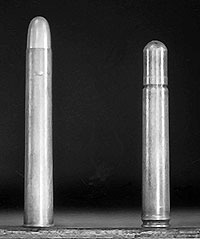|
There were problems to begin with, however. This was early days, remember, and hunting with these new rounds was an exponential learning curve. The most serious problem was fired cases sticking in the breech. The .450 N.E., being a rimmed round, was not suitable for bolt actions but instead found favour in double rifles and single shots. Both these actions lack the primary extraction power of a bolt action. Furthermore, the cases were becoming stuck in the first place for two main reasons. Firstly, some very early .450 N.E. ammunition was constructed with thin walled black powder cases, designed with 11 tons of pressure in mind. When subjected to 17 tons of cordite pressure, these cases of course swelled and stuck. Increasing the strength of the brass cases solved this problem. Another potential pitfall lay in the sensitivity of Cordite to ambient temperature. Loads which were developed and tested in the coolness (and coldness!) of England performed very differently when subjected to the 40 plus degree temperatures of the Zambezi Valley, manifesting signs of excessive pressure. Eventually the manufacturers responded with “tropical loads”, with reduced propellant charges which would not give problems in hot climates.
 |
| The .450 N.E. (L), next to the .458, its modern counterpart. |
|
Nonetheless, these initial problems gave rise to one or two different versions of the .450. Holland & Holland developed their own version, created by necking down the .500 B.P.E. case to .450 calibre. The slightly larger case capacity allowed the same ballistics at reduced chamber pressure (15˝ tons, to be exact). Jeffery also introduced the .450 No. 2 Nitro-Express, a huge, stoutly constructed beast of massive case capacity which gave a mere 13 tons of pressure. It was a seriously impressive looking round, but still pushed the same bullet weight at about the same speed as the original .450. By this time, though, all the ailments of the .450 Nitro-Express had been rectified. It was the undisputed darling of the hunting fraternity, and easily the most popular and widely used big game round. All was looking rosy for the .450, but clouds were gathering on the horizon.
Britain was undergoing a series of internal insurrections in the East, and one of the most popular and widely used rifles of the fractious anti-British locals was the .450 calibre Martini-Henry. In order to combat this problem, in the early 1900’s an administrative decision was made to ban the importation of all .450 sporting rifles and ammunition into India and the Sudan. This was to try and deny the rebels access to any pilfered sporting ammo for their rifles, and what of course was meant was .577/.450 black powder Martini ammunition. However, in typical bureaucratic style this blanket ban affected all .450 ammunition - including the .450 Nitro-Express. This was serious, as India especially was a favourite destination of the British sportsman and hunter. The Indian Maharajas also purchased a great many sporting rifles, and all in all India was a major market. If the .450 was banned, something else would have to be substituted.
This turned out to be a never-to-be-repeated opportunity to end all opportunities for the British gun - making firms. Competition was keen and rivalry was intense between them, and a scramble started to see who could develop another heavy round which would become the new industry standard. All strove to duplicate the performance of the .450 Nitro-Express with new rounds which were not quite .450 calibre. This gave rise to five other calibres, ranging between .465 to .476 in calibre, which all had virtually identical ballistics and gave the same performance on big game. There really is no practical difference between any of them. From then on the popularity of the .450 declined. Although still useable in Africa, the manufacturers concentrated on those calibres which were suitable for both Africa and India.
|